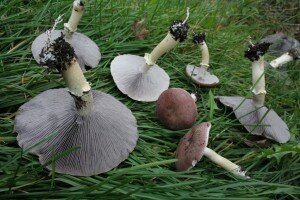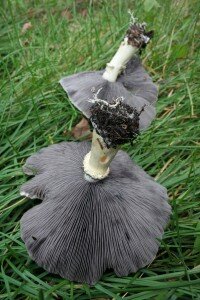The Sun-Loving King Stropharia
Strophs of all shapes and sizes!
Stropharia rugosoannulata’s regal appearance and distinctive potato and red wine flavor have earned it a colorful assortment of common names, including king stropharia, wine cap mushroom, garden giant, Godzilla mushroom, and stroph. Wild strophs pop up throughout the summer and fall, almost always fruiting on woodchips in landscaped areas or forest clearings. Once you find a patch, they may fruit repeatedly throughout the season following rain.
These saprophytic fungi are not difficult to cultivate in woodchip beds, often yielding massive fruits provided you do not make the common mistake of placing them in dense shade as you would shiitake logs. Many people are surprised that some mushrooms, including strophs, elm oysters, shaggy manes, giant puffballs, and most Agaricus species, actually favor habitats offering at least partial sunlight. I have seen strophs cultivated in the shade at two different sites in the Ithaca area; in this environment mycelium is typically able to colonize the woodchip substrate, but fruitings do not occur for a couple years and even then are highly sporadic. In contrast, garden giants grown in partial sunlight typically live up to their name, with mushrooms sometimes exceeding a foot in diameter and weighing well over a pound!
Strophs are an excellent mushroom to plant in the garden; not only do they enjoy sun, but they also seem to enrich soils. I first heard this claim made in mycologist Paul Stamets’ Mycelium Running, but my personal experience since then has also supported it. In the MacDaniels Nut Grove, a forest farm on the Cornell campus that I managed in 2009, strophs are cultivated in woodchips on top of rock hard, nutrient-poor soil. I was amazed recently to examine a bed that had produced strophs for two seasons in a row, and was running out of woodchip substrate to consume. Peeling back the thinning layer of woodchips, I felt fluffy, organic matter-rich soil left behind in their wake. While the pre-stroph soil had lacked any visible earthworms, it was now teeming with fat worms that were leaving behind their nutrient-rich castings, furthering this self-reinforcing cycle of soil fertility. Quantitative studies are needed to empirically demonstrate the effect strophs and other fungi have on soil fertility.
The lilac grey color of these gills indicates the mushroom is at a perfect stage for harvest!
Once you have a mother stroph colony, you never need to buy spawn again – to start a new bed, just use the colonized woodchips as spawn for fresh chips. If your mother bed is still small and you can’t spare too many chips, you can create your own cardboard spawn. To do so, you need either a handful of myceliated woodchips, or several stroph stem butts with their white root-like rhizomorphs in tact. Sandwich the colonized chips or stem butts between two sheets of moist, corrugated cardboard, and put this cardboard inside a cardboard box of plastic tub with air and drainage holes. You should see the mycelium jump from the chips or stem butts onto the cardboard within a week, and by the end of the month the cardboard should be fully colonized and ready to be placed mycelial face down on a fresh bed of chips.
The white, cord-like rhizomorphs projecting from the stem butt can be used to create cardboard spawn.
How do you know that the lovely mushrooms popping up out of your bed (or perhaps out of the mulch in front of the town police station) really are strophs? Though strophs are not a foolproof mushroom for beginner foragers, they are easy to recognize once you know what to look for. They are easiest to ID when found in a group with representatives of different maturity levels. Young buttons have deep burgundy red caps and pale gills, but as they rapidly grow, the cap fades to a muted tan color and the gills darken, going from off-white to a lilac grey before arriving at a dark, purplish slate color. The gills on emerging mushrooms are covered by a beautifully ornamented partial veil with tooth-like margins. As they mature, the partial veil drops, leaving an annulus on the upper stalk. This annulus so distinctive as to give the mushroom its scientific species name – rugosoannulata, or “ridged ring.” Indeed, the upper surface of the ring is lined with gill-like ridges.
And now, if you’ll excuse me, I must go to the refrigerator to retrieve my stroph harvest of the day, which I plan to sauté in butter with garlic until the edges start to brown. Within minutes, the smell of nutty potatoes and red wine will infuse my apartment, tempting my tongue to dig in. And dig in I will!
The deep burgundy color of these young caps gives the mushroom its common name, wine cap. Note the ornamented partial veil on the three specimens to the right, which will soon drop to form a ring as seen on the left specimen.



